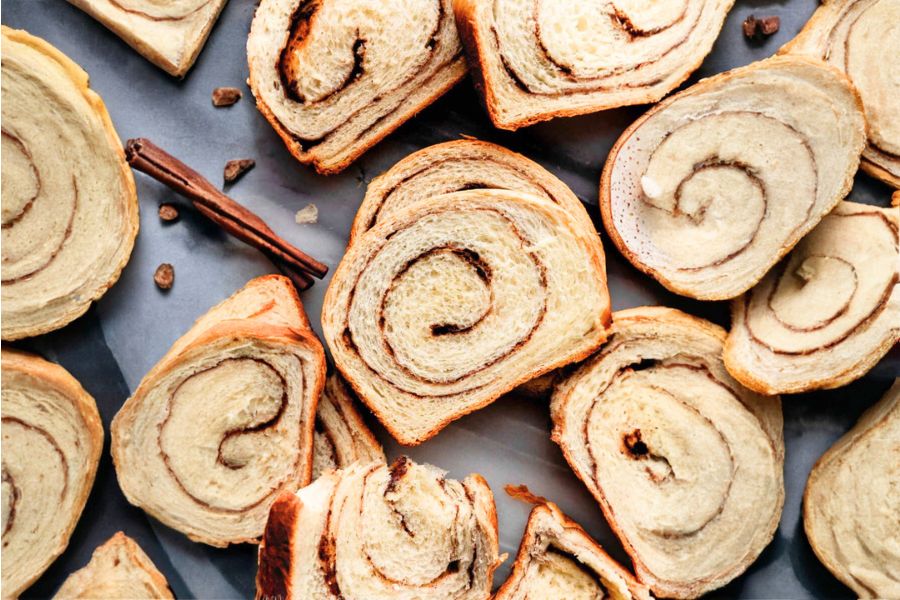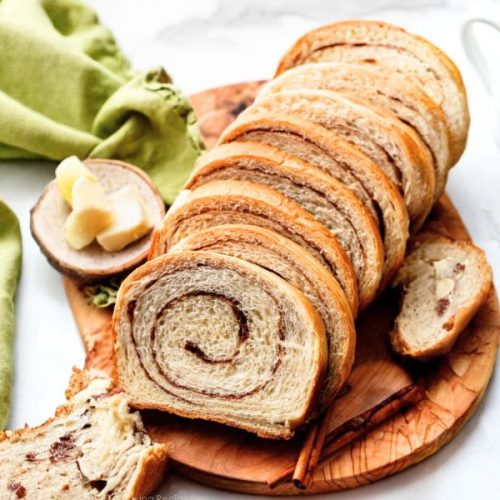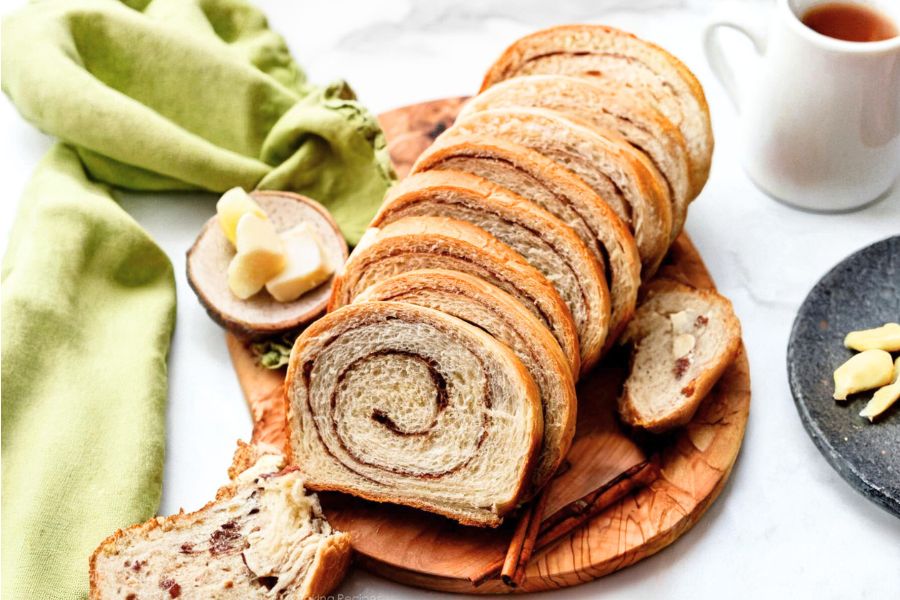This homemade cinnamon swirl bread transforms simple pantry staples into a soft, pillowy loaf layered with a rich, gooey cinnamon swirl.
Its appeal lies in the perfect balance of texture and flavor—the tender, airy bread contrasts beautifully with the sweet, spiced filling, making every slice irresistible.
Using bread flour enhances gluten development, creating a higher-protein, more satisfying loaf that keeps you full longer.
The recipe’s use of whole milk and butter delivers good fats while maintaining a comforting, homemade taste.
Easily customizable, you can add raisins or swap ingredients for dietary preferences, making it a versatile choice for breakfast, snacks, or even dessert.

Beyond indulgence, this recipe is approachable for everyday cooking: the step-by-step process is manageable, and the dough can be prepared ahead of time or frozen, perfect for meal prep or busy mornings.

Fluffy Cinnamon Swirl Bread
Equipment
- 1 Stand Mixer with Dough Hook
- 1 9×5-inch loaf pan
- 1 Rolling Pin
- 1 Pastry brush
- 1 Instant-read thermometer
Ingredients
For the Dough:
- 1/2 cup 120 ml warm water (~110°F/43°C)
- 1/2 cup 120 ml warm whole milk (~110°F/43°C)
- 2 1/4 tsp 7 g instant or active dry yeast
- 1/4 cup 50 g granulated sugar, divided
- 4 Tbsp 56 g unsalted butter, softened and cut into 4 pieces
- 3 cups 390 g bread flour, plus more as needed
- 1 tsp salt
For the Swirl & Topping:
- 1 egg white beaten
- 1/4 cup 50 g granulated sugar
- 2 tsp ground cinnamon
- 1 Tbsp 14 g unsalted butter, melted
Instructions
- Activate the Yeast: Begin by warming your water and milk to about 110°F (43°C)—just slightly warm to the touch, never hot. In a medium mixing bowl or the bowl of a stand mixer, combine the warm liquids with 2 tablespoons of sugar and the yeast. Stir gently to dissolve. Let the mixture sit for 5–10 minutes until it becomes foamy and frothy on top. This indicates the yeast is alive and ready to leaven your bread. If using a stand mixer, attach the dough hook and leave the yeast mixture in the bowl for this step.
- Combine Wet and Dry Ingredients: Add the remaining 2 tablespoons of sugar, softened butter, and 1 cup (130 g) of bread flour along with the salt to the yeast mixture.Mix on low speed for about 30 seconds until ingredients begin to come together. Scrape down the sides of the bowl to ensure even mixing. Gradually add the second cup of flour, mixing on medium speed until incorporated. The dough may look uneven with small chunks of butter—this is normal.
- Incorporate Remaining Flour: Add the last cup of flour and continue mixing on medium speed until the dough forms a cohesive ball that pulls away from the sides of the bowl.If the dough feels overly sticky, incorporate extra flour 1 tablespoon at a time until it becomes manageable. The final dough should feel soft, slightly tacky, but not overly wet or sticky.
- Knead the Dough: Keep the dough in your stand mixer and knead for 8–10 minutes on medium speed, or transfer it to a lightly floured surface and knead by hand. Stretch and fold the dough repeatedly, incorporating air and developing the gluten network. The dough should bounce back slowly when pressed with a finger. Perform the “windowpane test” by stretching a small piece of dough—if it forms a thin, translucent membrane without tearing, the dough is perfectly kneaded.
- First Rise: Lightly grease a large bowl with oil or nonstick spray. Place the kneaded dough into the bowl and turn to coat all sides with oil. Cover with a damp cloth or plastic wrap and leave in a warm, draft-free area for 1.5–2 hours, or until the dough doubles in size. The slow rise develops flavor and ensures a tender crumb.
- Prepare the Loaf Pan: Grease a 9×5-inch loaf pan generously with butter or nonstick spray. This ensures the bread releases easily after baking and helps achieve a golden-brown crust.
- Make the Cinnamon-Sugar Swirl: In a small bowl, whisk together 1/4 cup (50 g) sugar and 2 teaspoons cinnamon. This will become the sweet, spiced filling for your loaf. If desired, you can also fold in 3/4 cup raisins for a fruity variation.
- Shape the Dough: Once risen, punch down the dough to release trapped air. Lightly flour your surface, hands, and rolling pin. Roll the dough into an 8×20-inch rectangle, keeping edges roughly straight but not worrying about perfection. Brush the surface evenly with the beaten egg white, leaving a 1-inch border on one side. Sprinkle the cinnamon-sugar mixture over the brushed dough, distributing it evenly. Carefully roll the dough into an 8-inch log starting from the long edge with the filling. Pinch the seam to seal and place the loaf seam-side down in the prepared pan. Any extra cinnamon-sugar can be sprinkled on top for a richer crust.
- Second Rise: Cover the loaf lightly and allow it to rise for 1 hour, or until it is about 1 inch above the top of the pan.This final rise ensures the bread will be light and airy with a pronounced swirl in the center.
- Preheat the Oven: While the dough is rising, adjust your oven rack to the lower position and preheat the oven to 350°F (177°C). Baking on the lower rack helps prevent the top from browning too quickly while allowing the interior to bake fully.
- Apply Butter and Bake: Melt 1 tablespoon of butter and brush it lightly over the top of the loaf just before placing it in the oven. Bake for 35–45 minutes, checking halfway through.If the top begins to brown too fast, tent with foil to prevent burning. The bread is done when it sounds hollow when tapped or reaches an internal temperature of 195–200°F (90–93°C) on an instant-read thermometer.
- Cool the Bread: Remove the loaf from the oven and let it cool in the pan for a few minutes. Then transfer to a cooling rack to cool at least 10 minutes before slicing. Allowing the bread to rest ensures the swirl remains intact and the texture is soft and tender.
- Storage and Tips: Store leftover bread tightly wrapped at room temperature for up to 6 days or refrigerate for up to 10 days. For make-ahead options, freeze baked bread wrapped in plastic and foil for up to 3 months, or freeze dough after the first rise. Thaw overnight in the refrigerator and bring to room temperature before baking or slicing.
Notes
- Yeast Activation: Ensure water and milk are only warm (110°F/43°C). Too hot will kill the yeast.
- Flour Type: Bread flour gives a stronger rise and soft, fluffy texture; all-purpose flour may yield a denser loaf.
- Egg White Brush: Brushing with egg white before adding cinnamon sugar helps the swirl adhere and prevents gaps.
- Cinnamon-Sugar Variations: Mix in raisins, nuts, or chocolate chips for extra flavor and texture.
- Overnight Rise Option: Dough can be refrigerated overnight after initial mixing for richer flavor; allow it to come to room temperature before shaping.
- Baking Test: Use a thermometer (195–200°F / 90–93°C) for precise doneness, or tap the loaf—it should sound hollow.
- Freezing Instructions: Freeze baked or unbaked dough wrapped tightly; thaw overnight in refrigerator before using.€
Chef’s Secrets For Maximum Flavor
For the most flavorful cinnamon swirl bread, patience is key.
Allow the dough to rise fully in a warm, draft-free environment to develop natural sweetness and airiness.
Brushing the dough with egg white before sprinkling the cinnamon-sugar mixture ensures a seamless swirl and prevents the sugar from sinking or forming gaps.
Using high-quality butter enhances richness and tenderness, while warming milk improves yeast activity and consistency.
A slow, gentle knead creates a soft yet structured dough, producing that perfect tender crumb.
For added depth, refrigerating the dough overnight after the first rise creates a slightly tangy flavor and improves texture—ideal for planning ahead.
Serving Suggestions For Every Occasion
Cinnamon swirl bread is a versatile treat that works for breakfast, brunch, or a cozy snack.
Serve toasted slices with a pat of butter, cream cheese, or nut butter for a comforting start to the day.
It pairs beautifully with hot coffee, chai tea, or a glass of cold milk.
For a dessert twist, lightly drizzle with icing or serve with fresh berries and whipped cream.
This bread also works well for French toast or bread pudding, transforming leftovers into an indulgent but easy treat.
Storage Tips To Keep Fresh
Store your homemade cinnamon swirl bread tightly wrapped in plastic wrap at room temperature for up to 6 days to maintain softness.
Refrigeration can extend its life to 10 days but may slightly dry the crust.
For longer-term storage, freeze baked bread wrapped in plastic and foil for up to 3 months.
Unbaked dough can also be frozen after the first rise—thaw overnight in the refrigerator and allow it to reach room temperature before shaping and baking.
To refresh slightly stale slices, toast or warm them briefly in the oven for a few minutes to restore softness and aroma.
Frequently Asked Questions Answered Clearly
Can I use all-purpose flour instead?
Yes, but the loaf may be slightly denser with a softer rise. Bread flour is ideal for structure and chewy, tender crumb.
What’s the best yeast to use?
Instant yeast works perfectly, giving a reliable rise. Active dry yeast is also fine but may require slightly longer rising times.
How do I prevent gaps in the swirl?
Brush the dough with egg white before sprinkling cinnamon sugar and roll tightly. Poking a few small holes in the top allows steam to escape and keeps layers close.
Can I make this recipe dairy-free?
Yes, substitute plant-based milk like oat or almond milk and use vegan butter. The texture will remain soft, though slightly less rich.
How can I add extra flavor?
Incorporate raisins, chopped nuts, or chocolate chips into the cinnamon-sugar mixture. You can also experiment with a hint of cardamom, nutmeg, or orange zest for a unique twist.
This recipe has been adapted and simplified from the original version by sallysbakingaddiction. We’ve refined the steps for a smoother cooking experience and added helpful notes, nutrition insights, and essential kitchen tools to make it even easier for home cooks.

